
Comics vs. Cartoons: A Look at Diniverse Designs
February 14th, 2006 by Gavok | Tags: alan moore, angel, animated, avengers, badass, batgirl, Batman, bizarro, blue beetle, booster gold, cartoon, continuity, darkseid, DC comics, family, fantastic four, firestorm, flash, geoff johns, green lantern, grodd, harley quinn, hawk, hulk, ign, infinite crisis, interview, iron fist, john stewart, joker, justice league, krypto, kyle rayner, leader, legion of superheroes, lex luthor, manhunter, martian manhunter, Marvel comics, mastermind, movies, peter david, robin, rogue, silver surfer, skeets, storm, supergirl, superman, superman/batman, thor, ultimate avengers, vulcan, watchmenNext Monday seemingly marks the end of one of the greatest eras in animation. For fourteen years, we’ve been given what people call the “Diniverse” (named after a guy who barely writes actual episodes anymore). It started back in 1992 with a primetime showing of Batman: the Animated Series and after all these years, it’s going to die out with the finale for the fifty-eighth spin-off, Justice League Unlimited.
Lord knows the Diniverse made its stamp on both the world of animation and the world of comics. Characters like Harley Quinn were introduced… as well as more forgettable folk like Livewire and Lockdown. The comic version of Supergirl started wearing the white t-shirt and tight skirt made popular by Superman: the Animated Series. John Stewart took Kyle Rayner’s place as the token Green Lantern on the Justice League roster. Batman Beyond showed up in the pages of Superman/Batman for no reason whatsoever.
There are obviously changes here and there over how certain characters are portrayed. Many consider the Kevin Conroy-voiced Batman to be the defining version of the character, compared to the close-minded, paranoid caricature he’s become in the comics. Sure, the Joker kills people here and there on the cartoons, but at no point would they ever have him cripple Batgirl and strip her naked in order to drive her father insane on Cartoon Network. In the comics, Green Lantern and Hawkgirl have never been an item, nor has a big chunk of the JLU roster been members of any Justice League roster. Hawk and Dove sucked in both mediums, so there is that.
So let’s take a look at some heroes and villains who have shown up from time to time in the Diniverse. Were they improved? Did Bruce Timm fuck up? Is there some kind of third question? Let’s see together.
1) Amazo
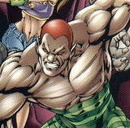
It was only natural that Amazo would show up on the animated series. After all, he was one of the original villains to challenge the Justice League of America, and definitely one of the most powerful. Created by Professor Ivo, Amazo was programmed to destroy the Justice League and came close due to his power to copy the abilities of the heroes he fought. Unfortunately, over the years, this ability has been a bit sketchy in terms of consistency. Depending on the story, Amazo was either built with artificial Justice League powers, or he could just copy their powers just by being around them.
While being recognized as a top threat, Amazo was never a big player, mainly because he has a basic computer mind and therefore had no real personality. Plus, even after all these years, he still has one of the silliest visual appearances in all comics. He shares something of a resemblance to Marvel’s Super-Skrull, whose powers are very similar. Just replace “Justice League” with “Fantastic Four”.
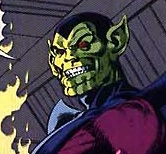
Other than losing a sweet fight against Batman and Nightwing, the Amazo moment that sticks out in my mind the most is the time he forced Superman to pull out all the stops and take him down in the silliest way possible.
As for the cartoon version, the folks at WB knew what they were doing with our robot friend. First off, they ditched the skull-cap/mummy-pants look and replaced him with something a bit more T-1000. Debuting in an episode fittingly titled “Tabula Rasa”, Amazo had a human personality, but the understanding of a child. His creator was dead, but he couldn’t understand the concept until Lex Luthor spelled it out for him. For the rest of the story, he wasn’t fighting the Justice League because he was programmed to. He was doing it because he was simply manipulated by a rat.
Cartoon Amazo’s character development through his few appearances shatters that of his simple-minded counterpart. With the ability to copy any power he sees, a trip through the cosmos has rendered Amazo to be one of the all-time most powerful beings in any superhero universe. After all, how superior could Thanos be with the Infinity Gauntlet, if Amazo could control all of time and space just by staring at it?
In his last appearances of the show, Amazo was shown as being part of Dr. Fate’s faction. In actuality, it was just a big reference to Marvel’s Defenders, with Amazo filling in the role of the Silver Surfer. Now with Darkseid back in the fold, one must wonder if Amazo will make his grand return to complete his purpose.
Judgment: Cartoon
2) Booster Gold
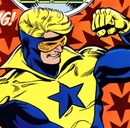
I’ll level with you. There isn’t much of a difference here. Booster Gold from JLU and Booster Gold from the comics are almost the same guy. I’m just including him for the sake of writing about Booster Gold.
Not to say that there aren’t any differences. For one, in the comics, Booster actually gets to say stuff every once and a while and exists as more than a prop. Skeets is less of a brown-noser in the comics, but is just as likeable. There are really two main differences. One, Booster in the comics never wore it on his sleeve that he’s from the future. Only the fellow heroes actually know the truth. Two, comic Booster had Blue Beetle to play off of.
Yeah, the comic version wins here. Not just for the Blue Beetle thing, but for the Batman dynamic. On the cartoon, Booster got bitched out by Batman. In the comics?
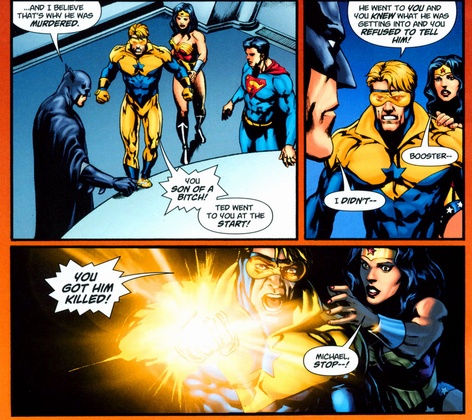
Judgment: Comic
3) Supergirl
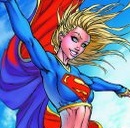
For the sake of simplicity, let’s start with the animated Supergirl. First showing up on the Superman cartoon, Kara was shown to be Superman’s cousin from a planet suburban of Krypton. Put in stasis, Kara was the only survivor. Since being brought to Earth, she lived with the Kent family, joined the JLU and then jumped into the future to join the Legion of Superheroes for reasons I don’t know because I haven’t seen the damn episode yet. If it had Gentleman Ghost in it, I’d be more inclined to watch.
There were about seventy-three different Supergirls in the comics, but I’ll go with the most recent one, Kara-Zor-El. After all, unlike Peter David’s “WTF angel” Supergirl, this one is a bit more similar to the animated counterpart. She is actually from Krypton and stuff.
Comparing these two isn’t even fair. JLU Supergirl isn’t the best character on the show, but she’s head and shoulders above this pretender from the comics with the fucked up torso. Granted, art and ignorance of Earth customs seems to suggest that Kara-Zor-El is flying free under her tiny skirt in the comics and that works to her favor, but sweet crackers is she boring. All she seems to do is whine about feeling alone while taking breaks punching in the faces of fellow heroes rather than the villains she’s supposed to smack around. Not only is she boring, but she’s just about shoved down our throats; showing up here and there with the theme that she just may be faster and stronger than Superman.
Judgment: Cartoon
4) Etrigan
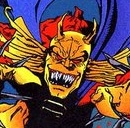
When he wasn’t written by John “Sloppy Retcon Machine” Byrne, the comic version of Etrigan spoke completely in rhyme. A complete bastard, Etrigan was never really Justice League material, even though Jason Blood was a nice enough guy to hang around for a bit. I have nothing against the cartoon version of Etrigan, but he behaves as more of a jerk, while the comic Etrigan behaves as more of a, you know, demon.
Nothing from Etrigan’s animated career can ever compete with the fact that at one point, comic Etrigan rhymed “orange” with “car hinge”. Now that’s impressive.
Judgment: Comic
5) The Shade

I was first introduced to the Shade from Justice League, where all he seemed to ever do is rob places and join supervillain teams. Something about his evil Mr. Peanut style appealed to me and I liked his pseudo-Green Lantern powers. Wasn’t too into the bit where he and Batman started kung fu fighting out of nowhere, but I’ll let it slide. What’s the main difference between this Shade and his ink and paper namesake? Cartoon Shade is concerned with his own mortality.
Comic Shade, on the other hand, is immortal. While cartoon Shade was a basic criminal with a neat supervillain twist, the Shade that came to life in James Robinson’s Starman is one of the greatest anti-heroes in all comics. With an origin that is only vaguely explained, Richard Swift gained immortality and his strange shadow powers almost 200 years ago. Before his time in the meta-human game, Shade was still annoyed and occasionally entertained by his rivalries with a dwarf named Simon Culp (stricken with the same abilities) and the Ludlows, a persistent bloodline obsessed with killing Shade.
Despite being an Englishman with love for his country, Shade mostly resides in Opal City; a city he deems so beautiful that he refuses to commit any crimes within its borders. Instead, he mentors Opal’s heroes, mainly Jack Knight, the latest Starman. It was only a matter of time before Shade’s various friendships led him to getting in touch with his own humanity and becoming almost a hero himself.
I like the cartoon Shade and all, but this isn’t close. He’s literally out-classed. And at least comic Shade didn’t try to bone a gorilla.
Judgment: Comic
6) Gorilla Grodd
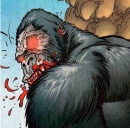
Gorilla Grodd in the comics is pretty hardcore, making him intense and intimidating when necessary. This is due to two things: 1) his feelings on committing genocide over all humans and 2) his habit of eating humans raw and alive while not even being bothered to wipe the blood from his mouth, even if it’s been there for hours. JLU can get away with Question/Huntress phone sex and jokes about Firefly’s dick size, but no way would this stuff ever be acceptable.
So they strip away all the interesting parts of Grodd and make him into a regular villain mastermind, only one who can’t be bothered to put on some pants. Not only that, but he uses awful phrases like, “There’s more than one way to peel a banana,” with a straight face.
Judgment: Comic
7) Killer Frost
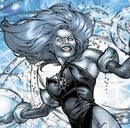
I haven’t exactly read too many Killer Frost-related comics, but Rad McHoatzin asked me to include her and I still owe him for saving my ass in ‘Nam. While evil and a bit vicious, there doesn’t seem to be too much to her comic form. She is a criminal, but she’s also more level-headed about things.
Contrast to JLU Killer Frost, who seems to have been frozen while in the middle of PMS. Actually… that would’ve been an amusing canon explanation for her behavior. But I digress.
The Killer Frost of the cartoons is ill-tempered and a completely murderous psychopath with a touch of goth. In other words, she’s hot. At no point have I seen her try to fight Firestorm here, so she’s definitely more intelligent.
Judgment: Cartoon
8) Captain Cold
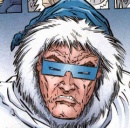
We follow a Flash villain and an ice-user with someone who’s both. I used to only know Captain Cold from the Superfriends, where he seemed like nothing more than Iceman from Megaman 1 with 3-D specks. In other words, I was disappointed that Black Vulcan never tried to zap him and press pause over and over again.
God, if that isn’t the nerdiest thing I’ve ever said…
Anyway! I mainly got to know comic Captain Cold through Geoff Johns’ 5-year run on the Flash. Being that Leonard Snart is just a guy with a freeze ray, constantly fighting a guy who can break the sound barrier in his sleep, Johns did a great job of building Captain Cold as a leader so competent that at no point during the run did Flash actually catch him and put him in prison.
There was also a notable sense of decency and honor that came with Cold. He didn’t kill unless it was personal or if he was threatened enough. He rarely tried to actually kill the Flash because he’s smart enough to know how the other superheroes would retaliate. The way he treats the other Flash Rogues (who he considers family) makes him seem like a responsible criminal and not a total monster like most in his position.
We haven’t gotten to see much of the cartoon version and therein lies the difference. “Flash and Substance” was about four Flash Rogues: Captain Cold, Captain Boomerang, Mirror Master and the Trickster. With the exception of taking down Orion with Boomerang’s help, Cold didn’t actually do anything of note. The other three got their own little segments, but Cold merely took the backseat. Even his leadership skills were undermined, as Mirror Master seemed to be running the show.
Finally, the comic version of Captain Cold isn’t the one who’s pussy-whipped. Nope, he’s just addicted to prostitutes instead.
Judgment: Comic
9) Despero
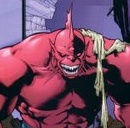
Like Amazo, Despero of Kalanor was one of the original threats to the Justice League. Back in the 60’s, Despero was an intergalactic conqueror that used his telepathy to help out-think the League. Twenty years later, the writers decided that this style wasn’t cutting it and therefore gave Despero a make-over. With a plot device called the Fire of Py’tar, Despero changed from a dorky intellectual to a hulking monster.
Comic Despero has it all: stronger than Superman, stronger telepathy than Martian Manhunter, a sizeable intellect and power that comes from his own hate. After his first major defeat in this form, pieces of him were scattered into space. Using only his pure hatred for the Justice League, Despero somehow pulled himself together and flew down to Earth for revenge.
Despero’s coolest moment was fighting the Justice League while wearing nothing but a tattered United Nations flag as a cape. Don’t worry, he’s anatomically incorrect.
Even though Despero was pushed as the anti-Martian Manhunter, he instead went after Green Lantern during his two-parter on the Justice League show. There, he was billed as a religious zealot on his planet Kalanor and ruled with an iron fist. He was far calmer than his comic self and was voiced by the gravely sweetness of Keith David. There was a coolness to him where I wouldn’t have minded if he had shown up in one or two more episodes. Unfortunately, he still couldn’t compete with the UN cape. That was too badass.
(Note: I made myself forget about Despero’s role in Justice League: Task Force and I suggest the rest of you do the same)
Judgment: Comic
10) The Question

The Question has been written in so many different ways over the years, but each one is likeable in its own way. His original incarnation made him to be a mysterious detective that snuck around to find answers that his news reporter alter-ego couldn’t. Later he became more of a martial arts expert with more of a desire to uncover the truth than justice. Most recently, Question has been portrayed as a drugged up shaman who talks to the very souls of cities and constantly pisses off Superman. Seriously, it’s fucking sweet.
Back in the 80’s, Alan Moore wrote the widely-loved Watchmen series with a main character Rorschach. Rorschach was originally intended to be the Question, but was later altered into this similar-but-different character. Rorschach was more unpredictable than Question ever was and definitely more messed up in the head.
Why do I bring up Rorschach? Because the JLU version of the Question seems to be based mostly off of Rorschach, only tamed down enough to fit on a cartoon show. In fact, JLU Question seems to be a hybrid of all his comic selves (other than the shaman version, who showed up after the cartoon debut), with a big chunk of Rorschach stuck in there. With Jeffrey Combs voicing him to perfection, Question comes across as creepy, but at times a great straight comedian. Maybe it’s because of how independent the comic version is (the only team Question’s ever been a part of is a really forgettable faction called Living Assault Weapons), making him seem out of place on an already bizarre team. Keep in mind that guys wearing tights think that a guy in an overcoat is the “weird one” when grouped with a cowboy, a knight and an old man with whiskers over his mask.
This seems like a pretty simple decision. JLU’s Question not only mixes all the best parts of his counterpart’s qualities, but is just about responsible for kicking off the big comeback Vic Sage is about to make in DC’s 52 series.
Judgment: Cartoon
11) Bizarro
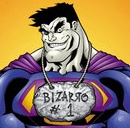
Like Supergirl, there have been many different incarnations of Bizarro in the comics. We’d be here all day if I went through every one, but most of them were failed clones of Superman that took part in backwards thinking. “Hello” means “goodbye” and “up” means “bad”. You know the drill. The current Bizarro, on the other hand, was a creation by the Joker, after he stole Mr. Mxyzptlk’s powers and used them to remake reality into his image. Even after Emperor Joker was dethroned and reality returned to normal, Bizarro continued to exist for some unexplained reason.
Currently, Bizarro is written in two ways. One is the obvious opposite talking version mentioned above, but in some comics (such as Infinite Crisis) he’s been shown to just be so completely unpredictable that you can’t tell what he means. If he tells you that you’re his friend, you really don’t know if he is sincere about it or is just calling you his enemy.
My favorite Bizarro moment is back in the 80’s in Alan Moore’s “What Ever Happened to the Man of Tomorrow”, where an outside force helps Bizarro realize that in order to be the perfect imperfect duplicate of Superman, he has to make his planet blow up on purpose, fly to Earth as an adult and begin to hurt and kill people. When confronted with Superman, Bizarro explains himself and then notes that Superman is alive. Therefore, Bizarro pulls out a rock of blue kryptonite and holds it against his chest, killing himself.
“Hello, Superman… Hello…”
Much like Question, the cartoon version of Bizarro is a mixture of all the things that make the character interesting without any of the unwanted continuity baggage. Despite being comic relief, Bizarro follows Mr. Freeze as one of the animated world’s most tragic characters. In his first appearance, Bizarro was a clone of Superman, created by Lex Luthor. Things seemed fine, up until he ran into the real Superman. The shock caused Bizarro’s genetic structure to have a fit and he became the sickly-looking, simple-minded creature we all know and love.
He continued to attempt acts of heroism, but due to his mentally challenged outlook, he often caused more damage than good. This led to one of my favorite scenes in any of the Diniverse cartoons, where the lab that birthed Bizarro was collapsing. Bizarro held the roof up and tried to sacrifice himself for Superman and Lois.
“Me hold! You save Lois! Me no am Superman, you am Superman! Superman always save Lois!”
Lois stopped, looked at Bizarro and said in a reassuring and surprised tone, “You are a hero.”
Bizarro showed up a couple more times, including a quick appearance on JLU, where his team-up with Giganta was meant to add to the massive Superfriends reference that was the “Ultimatum” episode. Ever since then, Bizarro has become a member of the Legion of Doom, where he not only fights for the forces of evil, but has begun talking in his trademark backwards-speak. While this would be considered out-of-character, Bruce Timm revealed the answer in an interview, which they probably wouldn’t have been able to mention on the show.
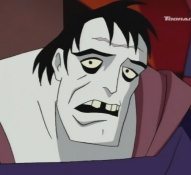
Notice the line going across his head? That’s not a ridge. Kind of a sad development, really. Poor guy.
Judgment: Cartoon
12) Deathstroke the Terminator (Slade)
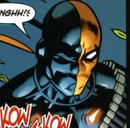
First thing’s first: let’s not split hairs. I don’t care if Teen Titans isn’t officially part of the Diniverse. It’s my list, chief.
Slade Wilson in the comics is nearly the opposite of Slade Wilson on the Teen Titans cartoon. For instance, the cartoon Slade wasn’t allowed to show up on JLU due to his role on Titans. Meanwhile, comic Slade shows up everywhere. Cartoon Slade claims to be no man’s servant. Meanwhile, comic Slade will do almost anything you want as long as there are enough zeroes on the check.
I’d say that comic Slade isn’t as evil as his cartoon self, but considering he just killed an entire city of people just because Nightwing irked him, I think I’ll pass.
They both have their own advantages and disadvantages. Comics Slade actually has a background, unlike on Teen Titans, where almost nobody had a background. Heck, the show never even explained why those five are together in the first place. Cartoon Slade looks far cooler, even though they never explained whether or not he looks like Colonel Sanders underneath the mask. Cartoon Slade gets credit for making the first two seasons of that show remotely watchable. Especially the first one.
The cartoon version was brilliantly voiced by Ron Perlman, and despite all the differences, I still hear his creepy voice when I read Deathstroke in every comic ever. I think that joke’s officially retired now. Thank you.
Being that Teen Titans is more of a kid’s show than JLU, they couldn’t get away with calling him “Deathstroke the Terminator”. I’m still unsure whether or not that’s for the best. Oh, the hell with it.
Judgment: Tie
The score has comic incarnations at 6 with cartoon incarnations at 5. Not that it really means anything. After all, I only picked some guys I both knew about to a decent degree and cared enough to write about. Had I added Toyman and Hawkman, the Diniverse would have won.
The fact is, this may be the best we’ll ever get. The character designs on The Batman are atrocious and I’ve heard bad, bad things about the new Ultimate Avengers movie.
But who knows? Maybe Amazo can stare at Peter Griffin and gain the power to come back from cancellation.

Good shit. Convinced me that I’ve been missing the boat on a lot of what you write.
There was an origin episode (well, more like a team assemblage episode) of Teen Titans in season five, but the majority of that season was so excremental I don’t blame you for having missed it
I’m surprised that Cartoon Flash/Comics Flash (different incarnations aside) wasn’t picked!
They can mention Doomsday getting lobotomized, but not Bizarro?
I loved your blurb on the Shade. Couldn’t hit it on the head any more than you did. 🙂